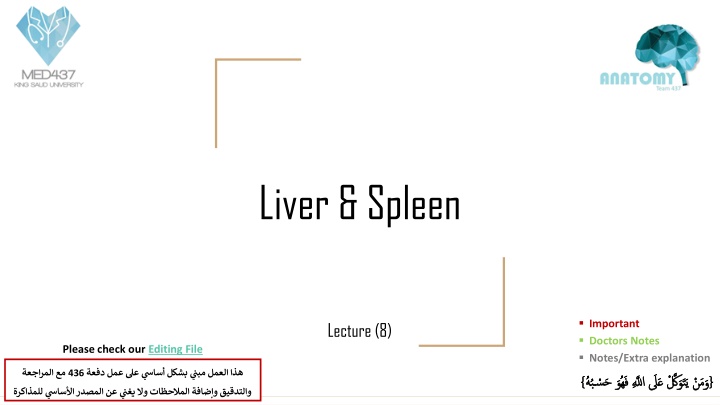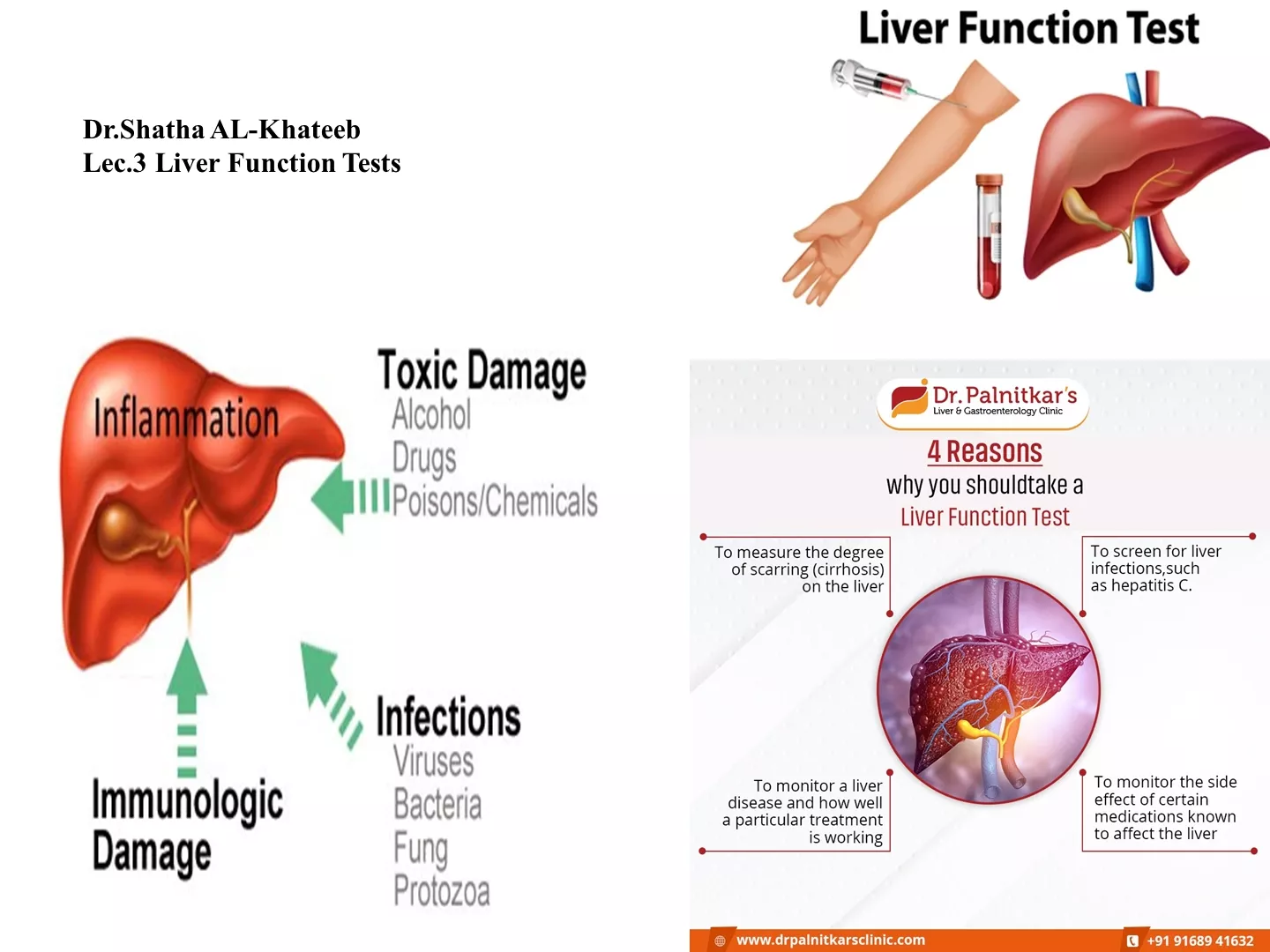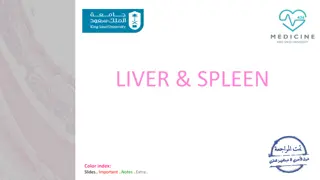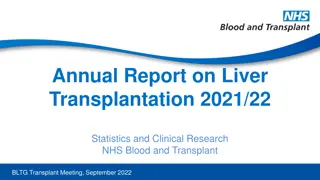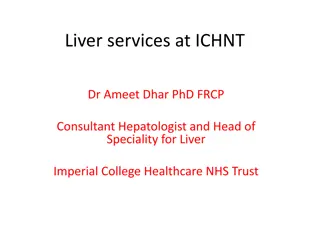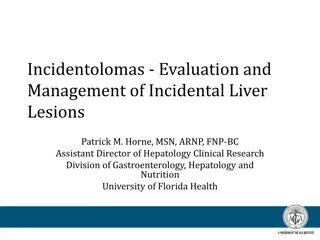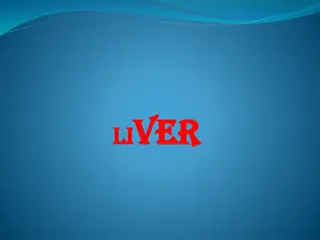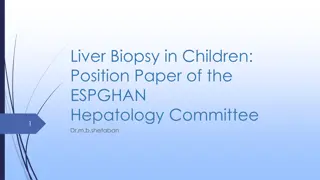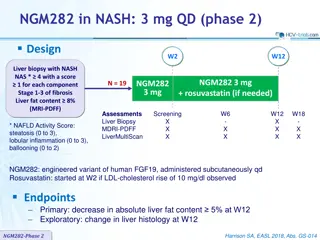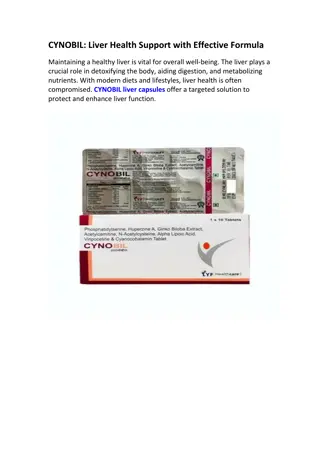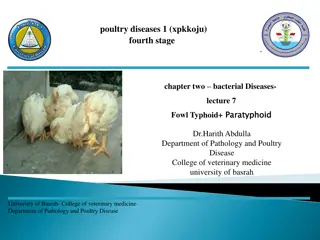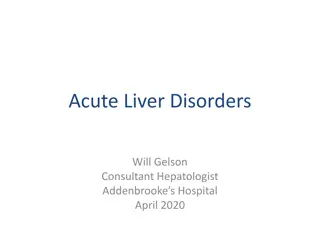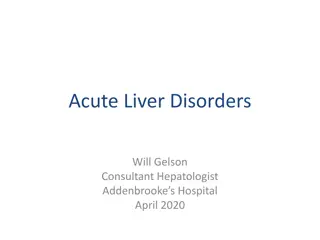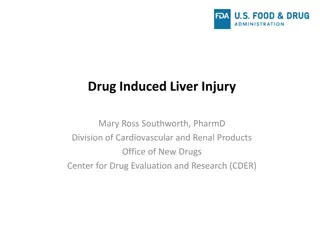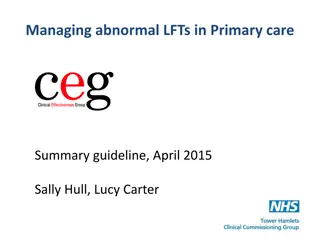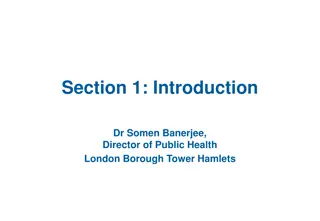Liver & Spleen
This lecture covers the location, subdivisions, relations, and peritoneal reflection of the liver and spleen, along with their blood supply, nerve supply, and lymphatic drainage. Detailed information on the liver's position, size, surfaces, and peritoneal reflection is provided, accompanied by images for better understanding.
Download Presentation

Please find below an Image/Link to download the presentation.
The content on the website is provided AS IS for your information and personal use only. It may not be sold, licensed, or shared on other websites without obtaining consent from the author.If you encounter any issues during the download, it is possible that the publisher has removed the file from their server.
You are allowed to download the files provided on this website for personal or commercial use, subject to the condition that they are used lawfully. All files are the property of their respective owners.
The content on the website is provided AS IS for your information and personal use only. It may not be sold, licensed, or shared on other websites without obtaining consent from the author.
E N D
Presentation Transcript
Liver & Spleen Important Doctors Notes Notes/Extra explanation Lecture (8) Editing File Please check our Editing File 436 { { } }
Objectives At the end of the lecture, students should be able to: Location, subdivisions ,relations and peritoneal reflection of liver. Blood supply, nerve supply and lymphatic drainage of liver. Location, subdivisions and relations and peritoneal reflection of spleen. Blood supply, nerve supply and lymphatic drainage of spleen.
Liver Liver Image result for youtube o The largest gland in the body. o Weighs approximately 1500 g (approximately 2.5% of adult body weight). o Lies mainly in the right hypochondrium and epigastrium and extends into the left hypochondrium. o Protected by the thoracic cage and diaphragm, its greater part lies deep to ribs 7-11 (when taking a biopsy from the liver it s taken from here)on the right side and crosses the midline toward the left below the nipple. o Moves with the diaphragm and is located more inferiorly when on is erect (standing) because of gravity. anteriorly and posteriorly. 10:07 Diaphragm is dome shape so it s seen Anterior relation Posterior relation IMPOETANT IN OSPE IMPOETANT IN OSPE 1.Diaphragm 2.Inferior vena cava 3.Right kidney and right suprarenal gland 4.Hepatic flexure of the colon 5.Duodenum (1st part), gallbladder, esophagus (lower part) & fundus of the stomach 1.Diaphragm 2.Right & left pleura and lower margins of both lungs 3.Right & left costal margins 4.Xiphoid process 5.Anterior abdominal wall in the subcostal angle
Liver Liver Peritoneal Reflection Peritoneal Reflection o The liver is completely surrounded by a fibrous capsule and completely covered by peritoneum EXCEPT the bare areas = Partially covered by peritoneum o The bare area of the liver is a triangular area on the posterior (diaphragmatic) surface of right lobe where there is NO intervening peritoneum between the liver and the diaphragm. o Boundaries of Bare area: Anterior: superior (anterior) layer of coronary ligament. Posterior: inferior (posterior) layer of coronary ligament. Right: Right triangular ligaments. Left : Groove for IVC o Other bare areas include: Porta hepatis, fossa for gall bladder, & groove for IVC (left boundary of bare area)
Liver Liver Surfaces Surfaces The liver has two surfaces: o A convex diaphragmaticsurface (Antero-superior, right lateral & small area of posterior surface) o A relatively flat or even concave visceral surface (postero-inferior) Diaphragmatic Surface The convex upper, anterior & right lateral surface is smooth and molded to the undersurface of the domes of the diaphragm which separates it from the base of 2 pleurae & lungs, pericardium, and heart. Covered with visceral peritoneum, except posteriorly in the bare area of the liver, where it lies in direct contact with the diaphragm. Visceral Surface (IMPORTANT) It is the posteroinferior surface, related to abdominal viscera. It is covered with peritoneum, except at the fossa for the gallbladder, the porta hepatis and IVC groove. It bears multiple fissures and impressions for contact with other organs. The visceral surface of the liver is related to the: 1- Stomach & duodenum (lower end) 2- Esophagus (lower end) 3- Lesser omentum (along margin of porta hepatis) 4- Gallbladder 5- Right colic flexure 6- Right kidney & right suprarenal gland Lesser omentum
Liver Liver Ligaments Ligaments Falciform ligament It is a two-layered fold of the peritoneum, ascends from the umbilicus to the liver. It connects the liver with the diaphragm and anterior abdominal wall & umblicus. (Attached to the anterior abdominal wall and posteriorly to the anterior & superior border of the liver) Its sickle-shaped free margin contains the ligamentum teres (round Ligament) of liver, the remains of the umbilical vein (oblitrated umbilical vein) , which carried oxygenated blood and nutrients from the placenta to the fetus. Ligamentum venosum It is the fibrous remnant of the fetal ductus venosus (oblitrated ductus venosus), which shunted blood from the umbilical vein to the IVC, in intrauterine fetal life short circuiting the liver. In fetal circulation, 50% of the venous blood coming from the mother goes to the liver and 50% shunts directly to IVC by the ductus venosus. ligamentum venosum round ligament
Liver Liver Lobes Lobes o The liver is divided into a large right lobe and a small left lobe (the difference in size is only anatomically not physiologically, since the caudate and quadrate lobes are functionally a part of the left lobe) by the attachment of the falciform ligament to anterior and superior surfaces. o The right lobe is further divided into a quadrate lobe (interior) and a caudate (superior) lobe by the presence of (1) the gallbladder, (2) the fissure for the ligamentumteres, (3) the inferior vena cava, and (4) the fissure for the ligamentum venosum. o The caudate lobe is connected to the right lobe by the caudate process.(demonstrates the opening of the lesser sac from above) o The quadrate and caudate lobes are a functional part of the left lobe of the liver. o The functional anatomy divides the liver into left and right lobes based on their relation to the division of common hepatic duct, hepatic portal vein, and hepatic artery proper into right & left branches, so the areas of the liver supplied by these branches constitute the functional left or right lobes. Caudate process
Liver Liver Fissures & Porta hepatis Fissures & Porta hepatis o Two sagittally oriented fissures, linked centrally by the transverse porta hepatis, form the letter H on the visceral surface. Left Fissure Right Fissure Anteriorly: by the fissure for the round ligament (ligamentum teres) Posteriorly: by the fissure for the ligamentum venosum. Anteriorly: by the fossa for the gallbladder Posteriorly: by the groove for the IVC. , o Porta hepatis (Helium of the liver): A transverse fissure found on the posteroinferior surface and lies between the caudate & quadrate lobes. o The upper part of the lesser omentum is attached to its margins. (the lips) o Structures passing through the porta hepatis include: Right and left hepatic ducts. Right and left branches of the hepatic artery Right and left branches of the portal vein Sympathetic and parasympathetic nerve fibers A few hepatic lymph nodes lie here; they drain the liver and gallbladder and send their efferent vessels to the celiac lymph nodes (final drainage). o The 2 hepatic veins open in the posterior surface on the groove for IVC Sometimes the IVC runs in a tunnel inside the liver. ligamentum venosum IVC IMPOETANT IMPOETANT round ligament Gallbladder Porta hepatis
The liver is held in its position by 3 things: 1. Hepatic veins main! 2. Peritoneal ligaments 3. Abdominal muscles Liver Liver Blood Circulation Blood Circulation Image result for youtube 08:11 o The blood vessels conveying blood to the liver are the hepatic artery (30%) a branch of celiac trunk, and portal vein (70%). o The hepatic artery brings oxygenated blood to the liver o The portal vein brings venous blood rich in the products of digestion, which have been absorbed from the gastrointestinal tract to the liver. o The venous blood is drained by right & left hepatic veins into the IVC o At or close to the porta hepatis, the hepatic artery and portal vein terminate by dividing into right and left primary branches which supply the right and left parts of liver, respectively. o Within the liver, the primary branches divide to give secondary and tertiary to supply the hepatic segments independently. o The hepatic veins, are intersegmental in their distribution and function, draining parts of adjacent segments, and they open in the posterior surface on the groove for IVC. o The attachment of the two hepatic veins to the IVC helps hold the liver in position. (The peritoneal ligaments and the tone of the abdominal muscles play a minor role in the support of liver). hepatic Vein hepatic arteries Portal vein
In portal hypertension (as from cirrhosis or hepatitis) the anastomosis areas dilate causing variant effects depending on the site, for example: Esophageal causes esophageal varices and hematemesis (vomiting blood) Paraumbilical causes caput medusa Upper anal canal cause hemorrhoids ( ) when the dilation burst and bleed. Liver Liver Supply Supply The liver produces a large amount of lymph about one third to one half of all body lymph. The lymph vessels leave the liver and enter several lymph nodes in the porta hepatis. The efferent vessels pass to the celiac nodes mainly. A few vessels pass from the bare area of the liver through the diaphragm to the posterior mediastinal lymph nodes. Sympathetic from the celiac plexus. Parasympathetic nerves: The anterior vagal trunk gives rise to a large hepatic branch, which passes directly to the liver. It is a specific type of anastomosis that occurs between the veins of portal circulation and those of systemic circulation In portal hypertion, these anastomosis open and form venous dilatation called varices ( ). Sites: -Esophagus (lower third part)(either systemic to the azygos veins or portal to the left gastric vein) -Upper Anal canal (immediately under rectum, between the superior rectal vein and the middle & inferior rectal veins) -Paraumbilical region -Retroperitoneal -Intrahepatic (Patent ductus venosus) Lymph Drainage Nerve supply Portal- systemic (portacaval) anstomoses IMPORTANT
Spleen Spleen o Largest single mass of lymphoid tissue (embryologically formed by the dorsal mesogastrium by collection of scattered lymph nodes) o Located in the left hypochondrium, deep to 9, 10 & 11ribs. o Its Long axis lies along 10th rib. o It is separated from the ribs by the diaphragm and the costodiaphragmaticrecess (space in pleural cavity). o Ovoid in shape with notched anterior border, while posterior border is round o Lower pole extends forward as far as the midaxillaryline. o Normal size spleen can not be palpated on clinical examination. (A healthy spleen is not palpable).
Spleen Spleen Relation Relation REMEMBER! Left colic flexure = splenic flexure Right colic flexure = hepatic flexure Anterior Posterior Diaphragm, that separates it from the left pleura (left costo-diaphragmatic recess) Left lung 9, 10 & 11 ribs Inferior Stomach Tail of pancreas Left colic flexure Left kidney Medial Left colic flexure Left kidney Left colic flexure Right colic flexure Higher Lower IMPOETANT IMPOETANT Away from the middle line Develops from the hindgut Develops from the midgut Supplied by the inferior mesenteric Supplied by the superior mesenteric Acute angle (less than 90 ) Rightangle (90 )
Spleen Spleen Spleen is completely surrounded by peritoneum which passes from its hilus as: Gastrosplenic ligament to the greater curvature of stomach (carrying the short gastric and left gastroepiploic vessels) Lienorenal (splenorenal) ligament to the left kidney (carrying the splenic vessels and the tail of pancreas care not to cut it in splenectomy). Diaphragmatic surface: is convexly curved to fit the concavity of the diaphragm and curved bodies of the adjacent ribs Visceral surface: related to viscera. The superior & anterior borders are sharp. Anterior border is notched. The posterior (medial) & inferior borders are rounded. Peritoneal Reflection | Ligaments Surfaces Borders
Spleen Spleen Supply Supply Image result for youtube 14:28 Largest branch of the celiacartery Runs a tortuous ( ) course (so when the stomach is full it won t collapse it will just elongate) along the upper border of the pancreas Passes within the lienorenal ligament Divides into 4-5 terminal branches, which enter the spleen at the hilus. Blood supply (Splenic artery) Leaves the hilus Runs behind the tail & body of the pancreas Reaches behind the neck of pancreas, where it joins the superior mesenteric vein to form the portal vein Tributaries: Short gastric vein | left gastroepiploic vein | Pancreatic veins | Inferior mesenteric vein Venous Drainage (Splenic vein) IMPORTANT Lymphatics emerge from the hilus and drain into several nodes lying at the hilum Efferents from the hilar nodes pass along the course of splenic artery, and drain into the celiac lymph nodes Lymph Drainage Derived from the celiac plexus (Innervation is purely sympathetic). Are distributed mainly along branches of the splenic artery, and are vasomotor in function. Nerve supply
SUMMARY SUMMARY LIVER SPLEEN Location Right & left hypochondrium and epigastrium Left hypochondrium deep to 9&10&11ribs Convex diaphragmatic Concave visceral Diaphragmatic(convex) visceral Surfaces Superior & anterior borders sharp Posterior & inferior round Borders - Splenic artery & vein (splenic v joins superior mesenteric v to form portal v) Hepatic artery(carry oxygenated blood) Portal vein (carry venous blood rich in nutrients) R&L hepatic vein drain venous blood into IVC Blood supply Sympathetic celiac plexus parasympathetic anterior vagal trunk Purely sympathetic celiac plexus Nerve supply Lymphatic drainage Celiac nodes Few vessels to posterior mediastinal lymph nodes Celiac nodes
MCQs (1) Which one of the following play a major role in supporting of liver? A) Hepatic veins B) Hepatic artery (6) Which of the following artery has tortuous course :- A) Hepatic artery B) Splenic artery D) Inferior mesenteric C) Superior mesenteric C) Peritoneal ligament D) Tone of abdominal muscle (7) The portal vein is form by joining of :- A) Splenic vein and superior mesenteric artery B) Splenic vein and superior mesenteric vein C) Hepatic vein and superior mesenteric vein D) Superior and inferior mesenteric veins (2) The main final lymphatic drainage of liver is :- A) Posterior mediastinal nodes B) Celiac nodes C) Superior mediastinal nodes D) Superior mesenteric nodes (3) The spleen is located in the left side deep to :- A) 7,8 and 9 ribs B) 10 rib (8) The liver lies mainly in the : A) Right lumber region B) Left hypochondrium C) 9,10 and 11 ribs D) None of above C) Right hypogastrium D) Right hypochondrium (4) The ligament that attached the hilum of spleen to the greet curvature of stomach :- A) Gastrosplenic ligament B) Lienorenal ligament (9) Which of the following lies posterior to the liver: A) The body of the stomach B) The hepatic flexure C) Splenorenal ligament D) Gastrohepatic ligament C) The jejunum D) The splenic flexure (5) The left colic flexure is related to the spleen :- A) Anteriorly B) Posteriorly (10) The lateral boundaries of the Bare area include: A) Superior triangular ligament B) Left coronary ligament C) Medially D) Inferiorly C) Posterior triangular ligament D) Right triangular ligament
Answers (1) A (2) B (3) C (4) A (5) D (6) B (1) B (8) D (9) B (10) D
SAQ 52 years old male, emigrated from Southeast Asia about 10 years ago, and has no specific complaints except fatigue. On examination you find little of note except that his liver edge is firm, is easily felt, and extends about 6 cm below the costal margin across much of the right upper quadrant. 1) What is the liver ? The largest gland in the body 2) Where is it located ? Lies mainly in the right hypochondrium and epigastrium and extend into the left hypochondrium. Its gather part lies deep to 7- 11 right side ribs and crosses the midline toward the left nipple 3) What protects it ? It is protected by the thoracic cage and the diaphragm. 4) What is the site of portal-systemic anastomoses? Esophagus (lower part). Upper Anal canal. Paraumbilical region. Retroperitoneal. Intrahepatic (Patent ductus venosus). 5) What is the feature that enable subtotal splenectomy? Lack of arterial anastomoses
Good luck Special thank for team436 Team Leaders: Faisal Fahad Alsaif Rawan Mohammad Alharbi Team Members: Abdulaziz Aldukhayel Abdulrahman Alduhayyim Rinad Alghoraiby Majd Albarrak References: 1.Girls & Boys Slides 2.Earthslab.com 3.TeachMeAnatomy.com Twitter.com/Anatomy437 Anatomyteam.437@gmail.com
